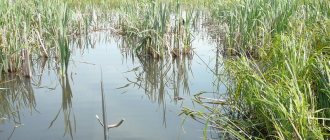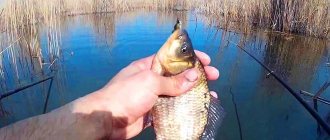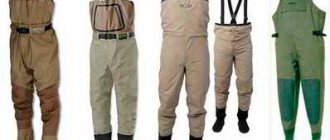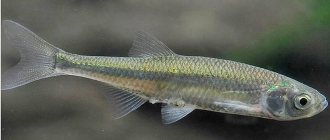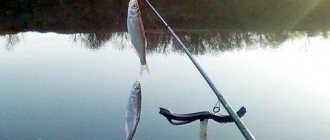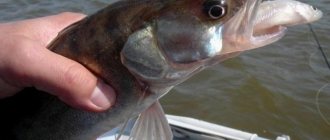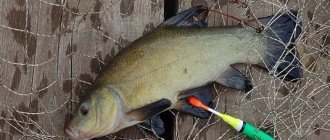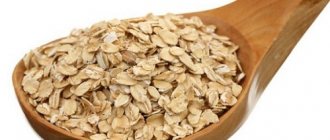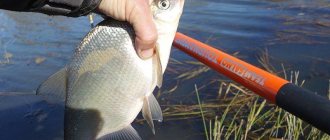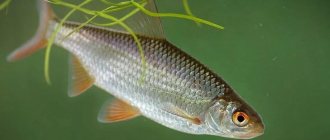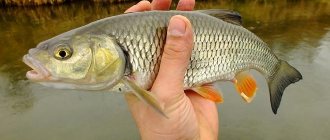Where to look for rudd
You can meet it in almost all corners of Russia, right up to Siberia. Among reservoirs, it prefers flowing ponds, reservoirs and lakes, but actively populates rivers with quiet currents, choosing places with the presence of aquatic and coastal vegetation, which it actively dilutes the diet with and uses as shelter from predators. Most often it is found in well-warmed shallow water, among thickets of holly, pondweed, hornwort, water lilies, or under a carpet of duckweed.
In sunny weather, the rudd feeds throughout the day and takes bait well in mid-water. Likes to stand in the shade of trees, bushes and reeds, picking up insects falling from them. In cloudy, pre-rain weather, it becomes more active and rises to the surface, hunting for flying insects that fall en masse into the water. Large specimens prefer deeper places, hiding among snags and rocks overgrown with algae.
When choosing a fishing location, the following factors must be taken into account:
- depth – 1-1.5 m (larger individuals – from 2 meters);
- flow – absent or weak;
- a visual landmark is a large amount of vegetation on the surface of the water, thickets of reeds or reeds.
- auditory landmark - the fish makes rather loud slurping sounds while feeding;
- Favorite habitats are shallow upper reaches of reservoirs, oxbow lakes, and river bays.
When is the best time to catch
Even on a frosty January day, a rudd can be seduced by the correct play of a jig. But still, it is thermophilic and its activity directly depends on the water temperature. From the beginning of May to the end of September it feeds intensively, the rest of the time the bite depends on numerous external factors.
There is a clear division of fishing by season:
- In winter, and throughout the entire period of ice, fishing is carried out on fine, sunny days in the usual habitats of fish. A good bite can only be expected in the first half of the day, provided there is no severe frost. The fish is cautious and reluctant to take bait, so it is advisable to fish with dull, matte jigs with a calm, even game.
- In spring, active fishing begins at the end of April, when the water temperature rises to 16-17 degrees. A good bite is observed in the late morning, when the sun sufficiently warms the top layer of water. After the May spawning, the biting time evens out, and the rudd begins to actively feed in the evenings.
- In summer, the most favorable period begins for a stable and confident bite. Fishing is carried out throughout the daylight hours, the bite becomes active in the early morning and in the evening twilight.
- In the fall, the rudd begins to intensively gain fat in anticipation of the onset of “hard” times. It prefers food of animal origin and during the active search it becomes less cautious and comes close to the shore, including large specimens. This period is the most successful for trophy fishermen. The activity of warm-water fish decreases greatly towards the end of October, when the water cools to 10-12 degrees. A rare bite can occur at any time on a short, sunny autumn day.
Gear selection
Rudd is one of the smallest representatives of the carp family, so you can use a fairly thin fishing line that can withstand the jerks of the fish and the weight of an armful of algae, which often have to be pulled out along with the fish. The choice of gear and fishing method is determined by difficult fishing conditions and the shallow lifestyle of the fish.
The following fishing methods can be used:
- on float equipment;
- into the wiring;
- in a plumb line on a jig;
- to ultralight.
- The most effective way to catch rudd is with a float rod. To install the equipment, use:
- A hard or medium-hard fly rod with a fast action, 5-7 meters long. The fishing rod should be light enough, since you will have to hold it in your hand for a long time. Carbon fiber rods with a test weight of 5-15 g are considered optimal. and a reinforced or hybrid tip. Budget, heavier rods made of composite materials up to fiberglass are also used.
- Monofilament line with a diameter of up to 0.25 mm or braided cord with a diameter of up to 0.08 mm. Since the casting range usually does not exceed 15 meters, it is better to use a more expensive, but less noticeable thin cord, which allows you to more clearly record the bite and land the fish faster. To prevent the rudd from having time to hide in the thickets, the length of the mounted equipment should not exceed the length of the rod. The leash is used an order of magnitude thinner than the main line. It is best to use fluorocarbon, which when wet becomes almost invisible. The color design of the main line should contribute to its maximum camouflage or imitate the brown-green sprout of an aquatic plant.
- A lightweight drop-shaped float weighing 5-10 g, with a transparent base to be less noticeable to the fishing object. The float mast, on the contrary, should stand out; it is painted red, yellow or another contrasting color. Long waggler-type floats with fastening at one point are suitable for fishing. For some modified fishing methods, water-filled floats are used to adjust the buoyancy of the bait.
- Hook, used No. 3-5 with a short or long shank, depending on the type of attachment.
- It is best to use a spindle-shaped sinker, in the shape of an olive or a pellet ball. Usually one lead sinker fixed 2-5 cm from the hook is enough, but you can attach a second one - hooking it immediately behind the leash. Sometimes, for more accurate casting, sliding sinkers are used. When fishing for rudd near the surface, it is enough to unload the float itself directly, securing the sinker immediately behind it.
- The distance from the hook to the float is determined by the distance to the bottom: if the depth of the reservoir is 1.5 meters, then in order to catch rudd at half-water, it is necessary that the distance between the hook and the float be 70-80 cm. If fishing occurs closer to the surface - 20 -30 cm or even less.
- Wiring fishing is used in bodies of water with a small current. The bait, using a float rod, is thrown onto the border of clean water and aquatic thickets or into a sufficiently large window. A boat is often used to provide access to such areas. Rudd, accustomed to sharply grabbing passing food, can be caught well with such gear.
- Plumb fishing with a jig is used in cases where the reservoir is covered with a continuous carpet of duckweed or other aquatic plants. The equipment is installed without a float and a hook; they are replaced by a jig. The line is shortened to half the length of the rod. To increase the sensitivity of the tackle on the rod, a side nod is used (this can be done with a winter fishing rod). When using vertical gear, wading fishing tactics or fishing from a boat are often used.
- Fishing for rudd using ultralight is used mainly in spring and autumn, when the reservoir does not have time to be covered with aquatic vegetation. A rod with a test weight of 5-10 g is used. and up to 2 m long, for the ability to perform side casting. The bait is small rotating spoons, miniature wobblers (minnow, popper, walker) and vibrating tails made of edible silicone.
To catch rudd, a number of fishing methods and techniques are used: feeder fishing, drag fishing, fly fishing, bale fishing, etc.
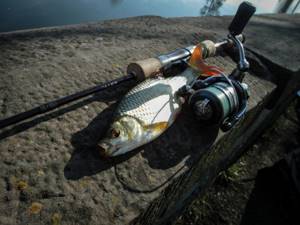
Equipment and catching rudd on a spinning rod
Rudd on a spinning rod is caught in areas of coastal vegetation and reed walls, on the borders of the approach of algae to clean water. For fishing tools, choose ultra-light spinning rods with weights not exceeding 7 grams. According to the ultralight concept, a spinning reel and the thinnest main cord are selected, not exceeding the diameter of 0.08 mm in braided line and 0.2 mm in monofilament. Lures are tied directly to the line, without fasteners or carabiners, which make the tackle rough. For bait they take mini-wobblers, cranks due to their structure and the ability to play independently. The size of a wobbler of 1.5-2 cm in the likeness of a grasshopper or fly is a fairly common option for this type of hunting.
Of the spinners, the preferred ones are rotating ones with drop-shaped silver petals, without any kind of bait. From silicone baits, short but thick worms and something like narrow fry are used. The color of these baits does not play a special role in fishing. Catching rudd on a spinning rod with silicone bait is carried out according to the jig principle, with step-by-step retrieval in the water column. The wobbler is carried out in a twitching style with minimal pauses and distinct jerks, reminiscent of the movement of a water cutter insect along the surface of the water. The rotating spoon is driven in a leisurely monotonous manner. Bites, as when fishing with a bombard, are given by a single blow with a malfunction of the bait, which requires immediate hooking and retrieving the hooked trophy.
Bait for rudd
Using bait allows you to collect fish in one place and significantly increase fishing efficiency. For attachment, both plant and animal food components are used, which can give the bait maximum buoyancy. Often used:
- The crust of any baked goods, preferably thrown to the fishing point on a separate fishing line along with a small sinker-anchor. This primitive design allows you to keep the bait in one place and easily replace it. Floating on the surface, the bread forms a cloud of food turbidity around itself, which attracts whole schools of fish. The bread can be pre-fried in any vegetable oil.
- Store-bought bait is sold in bags weighing 1-2.5 kg. The mixture is made from large fractions of grain crops with the addition of flavors and has neutral buoyancy.
- Homemade bait is the most universal means of luring rudd, since it allows you to take into account the subtleties of the fish’s diet in a particular body of water. The basis of the bait is often pearl barley, millet, millet or makha. It is advisable to add vegetable oils, flavors and a “dusting” ingredient that can quickly spread and form a food trail. Semolina, breadcrumbs, flour, crushed cookies are suitable for this. Often an animal component is added: small insects, maggots, chopped worms and bloodworms.
Small balls are molded from the bait and thrown into the fishing point. When attracting a promising place, you must always remember that the main task is to lure, not feed.
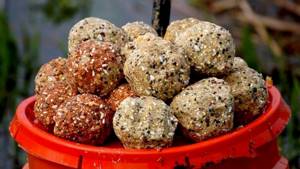
Features of choosing bait
Since the rudd is extremely unpretentious in its choice of food, preparing bait will not cause any particular difficulties. You can choose virtually any type of store-bought bait mixture , and it will attract the attention of the prey to the right place.
The only thing you need to take care of is that this bait should not sink.
This can be achieved as follows:
- Pour the purchased mixture into any container.
- Dilute with water, it is best if it is taken directly from the reservoir where fishing will be carried out.
- Stir the mixture until it has a dough-like structure so that small lumps can be formed.
- Throw the resulting lumps into the water, and you need to throw bait near these places, since the rudd will most likely linger near them for a very long time.
You can also prepare the bait yourself , it also won’t take much time, and the process will look like this:
- The crust of any bread is used as complementary food, which is attached to a sinker using a fishing line.
- Adjust the length of the line so that the distance between the sinker and the bait is greater than the depth of the selected place.
- The opposite end of the fishing line is tied to a stick, which is fixed on the shore.
- A crust of bread is thrown into the intended fishing area and will remain on the surface. Thus, it will not only attract prey to it, but will also always be in the fisherman’s field of vision.
Bait selection
- Rudd can be called an omnivorous fish, so a wide variety of baits are used:
- Dough and semolina, with the addition of bright dye and a sweet ingredient.
- Bread, preferably rye, rolls the crumb into small balls, which are placed on a hook.
- Insect larvae: maggot, caster (pupated maggot), caddisfly, centipede mosquito larva (bloodworm), bark beetle larva and dragonfly;
- Insects, bait can be a fly, small grasshopper, mayfly, cricket, gadfly, various small beetles.
- Cereals, most often pearl barley, peas and corn are used, but you can try fishing with any grain.
- Worms, both earthworms, dung worms and white peat worms are suitable. It is necessary to give them the opportunity to free their intestines from the soil by placing them in bran or damp moss for a day.
- Artificial baits, you can use colored foam balls together with a floating feeder, silicone simulators of maggots, worms. When fishing with a spinning rod, small rotating spoons, wobblers and twisters made of soft silicone are used. Sometimes artificial flies, especially brightly colored ones, work well.
- Depending on the time of year, the rudd may change taste preferences:
- In winter, 3-4 mm jigs and baits of animal origin are used for fishing, mainly bloodworms, maggots, and burdock moth larvae. No less catchy, but difficult to obtain: amphipod larva, caddis fly, pieces of leech;
- In the spring, in cold and muddy water, mainly animal baits are used: bloodworms and dung worms, but you can try to fish with colored dough. This period is favorable for spinning bait using small artificial baits. After spawning, the bite on baits of plant origin becomes more active.
- In the summer, you can use any bait with equal success, and it all depends on the individual characteristics of the reservoir. Bait from winged insects brings excellent results: flies, grasshoppers, horseflies.
- In autumn, there is a gradual abandonment of plant foods. By mid-October, the main diet consists of larvae and worms. Good results are achieved by using small spinners.
- The choice of bait can be influenced by water transparency:
- In case of cloudy water, it is better to use brighter baits: red worm, bloodworm, tinted dough, pea mastyr.
- In clear water, the rudd spends most of its time close to the surface, and such light-colored baits as maggots, semolina, and bread are clearly visible to it.
- Some baits you can prepare yourself:
- The dough is kneaded according to numerous recipes, starting with two components (water and flour) and ending with a dozen ingredients. Quite good results are demonstrated by a stiff dough made in the following way: 1 part semolina and 4 parts wheat flour are mixed together. Add pink (or red) food coloring, a little honey and crushed roasted seeds. For greater stickiness, beat in an egg. The result is a fragrant, sweet, colored dough that holds well on the hook.
- Mastyrka is prepared from assorted semolina and pea flour. To prepare mastyrka, you need to boil several glasses of water in a saucepan. Add half a glass of pea flour and, stirring constantly, cook until a homogeneous mass is obtained. Semolina is added in an amount sufficient to remove excess water. The pan is removed from the heat. Add a few egg yolks, a spoonful of honey and a bag of vanilla sugar. Add semolina in small portions until the consistency of the mixture resembles dough. The mastyrka is thoroughly kneaded in order to achieve the elasticity of the plasticine.
- Special attention must be paid to storing live bait. If handled correctly, it can be used for several weeks or even months. The bait feels best in an air-permeable wooden container at positive temperatures close to zero, on the bottom shelf of the refrigerator. If there is a need to preserve bait of animal origin in the field, proceed as follows:
- Bloodworms - stored in a foam or wooden box on damp foam rubber; as the foam dries, it becomes wetted.
- Maggot - feels great in a glass container, sprinkled with bran and sand.
- Caddisfly - must be in a humid environment. To do this, it is kept in a jar half filled with wet moss. For caddisfly larvae, mayfly and its larvae, the jar is filled with water.
- Grasshopper, cricket, fly and other flying insects are kept in a ceramic or glass container with a narrow neck filled with fresh grass.
- Worms - stored in a foam or wooden box filled with bran, moss or native substrate.
There are several general rules to ensure the survivability of bait:
- the container intended for storing bait must allow air to pass through in sufficient quantities;
- To ensure a cooler storage microclimate, containers with bait should be wrapped in a damp canvas rag or bag.
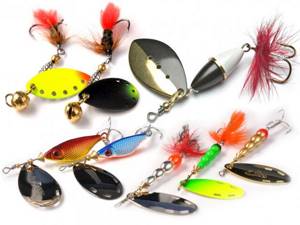
What to feed
The bait for rudd is similar in composition to that which is usually used when fishing for roach. It is prepared so that its density allows it to remain in the upper and middle layers of the reservoir for as long as possible. This can be stale wheat bread, previously soaked and passed through a sieve, with the addition of bran and breadcrumbs. Before casting, the bait is formed into small balls. It is also practiced to add maggots, worms, grasshoppers, small snails or crushed dung worms to the bait.
Read more
Catfish spawning
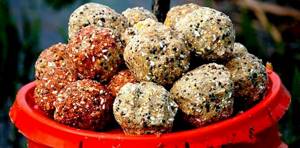
It is possible to use purchased ready-made mixtures for rudd, but they all sink in water
How to catch rudd (fishing technique)
The rudd is extremely cautious and timid. The fisherman must follow all possible camouflage methods: wear dark, preferably camouflage, clothing, hide behind bushes, do not make unnecessary sudden movements, and most importantly, do not make noise or talk loudly. If possible, prepare the fishing area in advance, remove interfering plants and snags.
When fishing with a float rod, you must start by casting bait to a depth of 30-40 cm, and then, if there is no bite, fish the bottom and surface areas.
If necessary, use bait:
- One effective fishing technique is to cast bait onto a lily pad. After waiting a few seconds, you need to carefully pull the bait into the water. This will allow you to not create any noise and catch fairly large fish.
- You can use a slow-sinking float technique that allows the bait to travel from the surface to the bottom. To do this, it is necessary to attach an additional sinker under the float itself, which will disrupt its buoyancy.
- For fishing near the surface, you can use a water-filled float, which also serves as a sinker. In this case, the bait will lie on the water; insects and bread are best suited for this.
Who is Rudd
The main difference is the fins, especially their tips; they are piercing red. Here it is simply impossible not to remember how Leonid Pavlovich Sabaneev described this fish a hundred years ago: “... its back is brownish-green, its sides are shiny yellowish-golden, and the edges of its scales have a golden-brown border; the eyes are orange, with a red spot in the upper half; the dorsal fin is blackish at the base, red at the top, the pectoral fins are gray, also red at the top, and all the rest are bright red, even crimson.” Well, tell me, why not a portrait of a beauty!
Read also: Nozzle - semolina chatter
Where can I find it? Rudd is an unusually cautious fish. Even the shadow of a fisherman sitting motionless in his boat will immediately scare it away, so the fishing rods will have to be placed on the sunny side and fished until you have the strength and patience to withstand the bright sun glare on the flat surface of the water with your eyes. Rudd simply loves thick algae and weak currents, and even more loves calm water.
This is a sedentary fish and is not accustomed to changing habitats. Usually she chooses the average depths of lakes, bays, and oxbow lakes. The rudd is partial to water lilies, but most of all it loves thickets of horsetail and pondweed. The rudd is not just a cautious and cunning fish, it is also smart. Judge for yourself: not a single poacher will ever boast that he caught a rudd in a net. It is simply impossible to catch them with a net; these fish do not fall into traps, nonsense, or other cunning traps.
Wiring when fishing for rudd
Growing over 100 grams, the fish begins to show predatory tendencies and is able to eat fry, which explains the possibility of catching it with ultralight. The trolling technique is performed by uniformly reeling in the fishing line at a low but sufficient speed to keep the bait near the surface of the water. You can use a “stop and go” retrieve, allowing the bait to sink a little deeper and immediately lift it up. Sometimes an effective beak is facilitated by the use of twitching elements.
Fishing Features
Rudd is a daytime fish; as evening approaches, it moves to the depths and roosts for the night among dense vegetation. The shorter the day and the lower the water temperature, the more time the fish spend on the bottom. In the cold season, fishing must be done in the first half of the day, choosing sunny weather for this. Live baits and small artificial baits are used, which are lowered closer to the bottom. As the water warms, fishing is done closer to the surface, and plant baits are added to the arsenal of baits.
Fishing is done both from the shore and from a boat. In the absence of a watercraft, a wading suit is often used. When fishing from the shore, you will need good casting skills and the ability to be invisible to the fish.
To do this, casts must be made through the grass, which covers the squatting angler. Fishing from a boat significantly expands the possibilities of fishing “interesting” places. Allows you to use shorter rods, cast gear to the border of clear water and vegetation, stand upwind and fish coastal areas. The bow of the boat can be camouflaged with an armful of vegetation.
Plumb fishing with a jig makes it possible to effectively fish even among thick algae. To do this, the angler slowly moves around the reservoir and fishes different layers of water, lowering and raising the jig through the carpet of greenery.
For fishing from the surface, a sinker is often not installed on the tackle, and a bulk or loaded float serves as the casting weight. Using a sinker on the rig allows the hook with bait to break through the plants and fish at great depths.
To use a “retractable leash” type tackle with several hooks, use a special transparent float with built-in “Bombarda” or “Sbirulino” scales. In the tackle, it is used instead of a sinker and allows you to make long, accurate casts even in strong winds. Hooks can be attached both before the float and after it.
During periods of cold water, you can often catch rudd on a feeder with a small feeder filled with porridge. Fly fishing for rudd is perceived as something exotic, but she clearly liked trout flies, especially for large specimens.
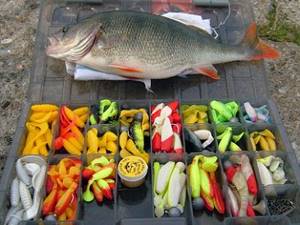
Lure
A frisky fish that feeds on the surface and in the depths of the water often does not need additional feeding. After all, life in a huge flock forces any individual to instinctively go to the bait spotted nearby and immediately swallow it, fearing for the loss of a particle of food to a more cunning and arrogant neighbor. Therefore, the fisherman only has to know the location of the school of fish and deliver a bait-equipped rig to this area. But if the angler wants to achieve more significant results in catches than catching small things of 50 grams, then you need to use complementary foods, collecting rudd on a muddy spot in addition to small things and more respectable in size.
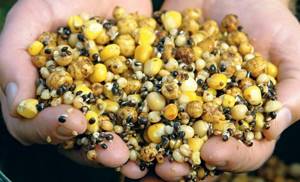
Important! Based on the behavior of individuals when feeding, you need to understand that complementary foods should not quickly reach the bottom of the reservoir, but, optimally, create a cloudy spot in the fishing area for a long time with fine dust of edible particles that smoothly settle from the surface to the bottom of the reservoir.
The bait for rudd should be in the feeding spot, as the largest nutritious object in size, which will be grabbed by one of the largest fish.
Important! Groundbaits are prepared as dusty mixtures that are light in weight and small in fraction, which is often achieved by additional grinding and drying of the products used in the mixes.
These feed conditions are achieved using breadcrumbs, ground semolina, milk powder and feed dust. The bases for bait are made from millet porridge or boiled and crushed peas. The mixtures are moistened without bringing the mass to a wet consistency, leaving them semi-dry, crumbly and dusty in the water when casting. Common culinary spices such as vanilla and cinnamon are suitable as attractants. From liquid, concentrated odorous solutions intended for fishing mixtures, the addition of chicory, honey and tutti-frutti is especially effective in gathering a school of fish for casting to the feeding point.
When fish activity is low, especially in late autumn and during ice fishing, small crushed bloodworms and dung worms chopped or cut with scissors into small pieces are used in the bait. When catching live bait, and this fish in many cases is ideal for this role, crusts of fresh bread are thrown into the fishing zone as bait, which, when soaked, gradually settle into the water column, attracting the little things that are so needed at that time in the catch.
Blitztips
- On a cool day, rudd stay at medium depths.
- For fishing, you need to select several “windows” and after catching 3-4 rudds, change your location, since the frightened large fish temporarily leaves this place.
- Often, together with the rudd, you have to pull out a heavy armful of vegetation, due to which the fish can fall off, so it is advisable to use a landing net.
- You can learn about the diet of rudd by opening the stomach of several caught fish. This will allow you to quickly select the desired nozzle.

